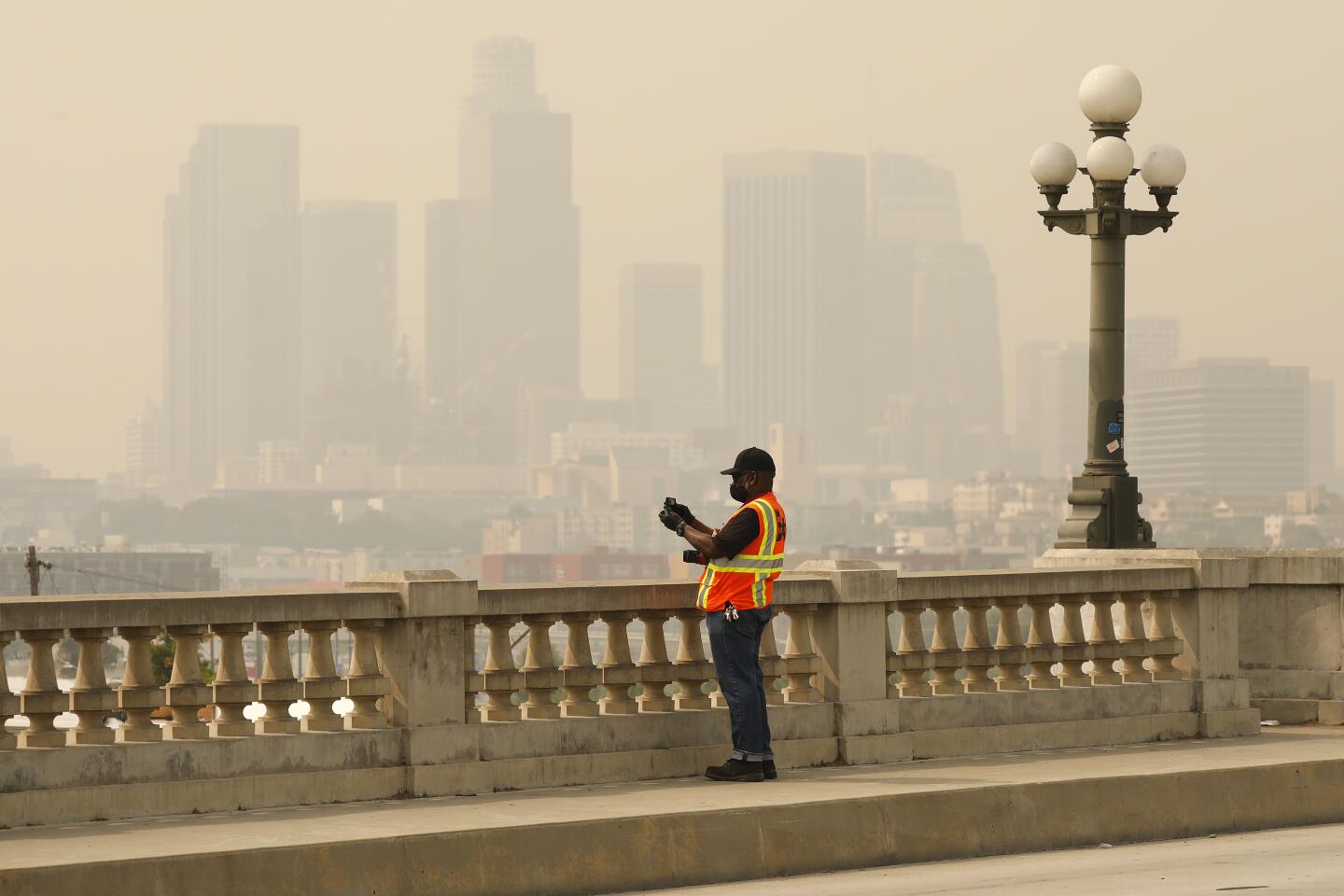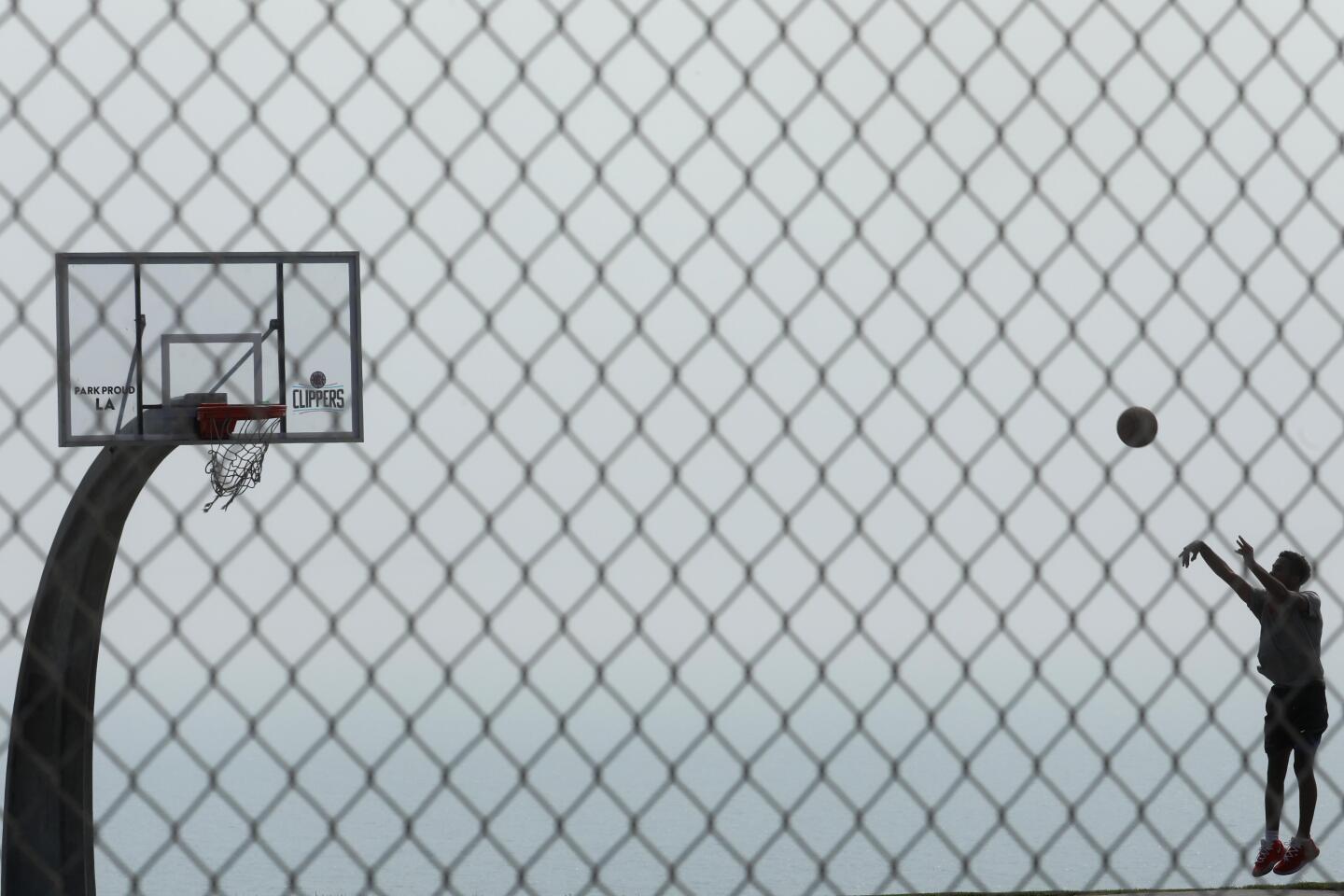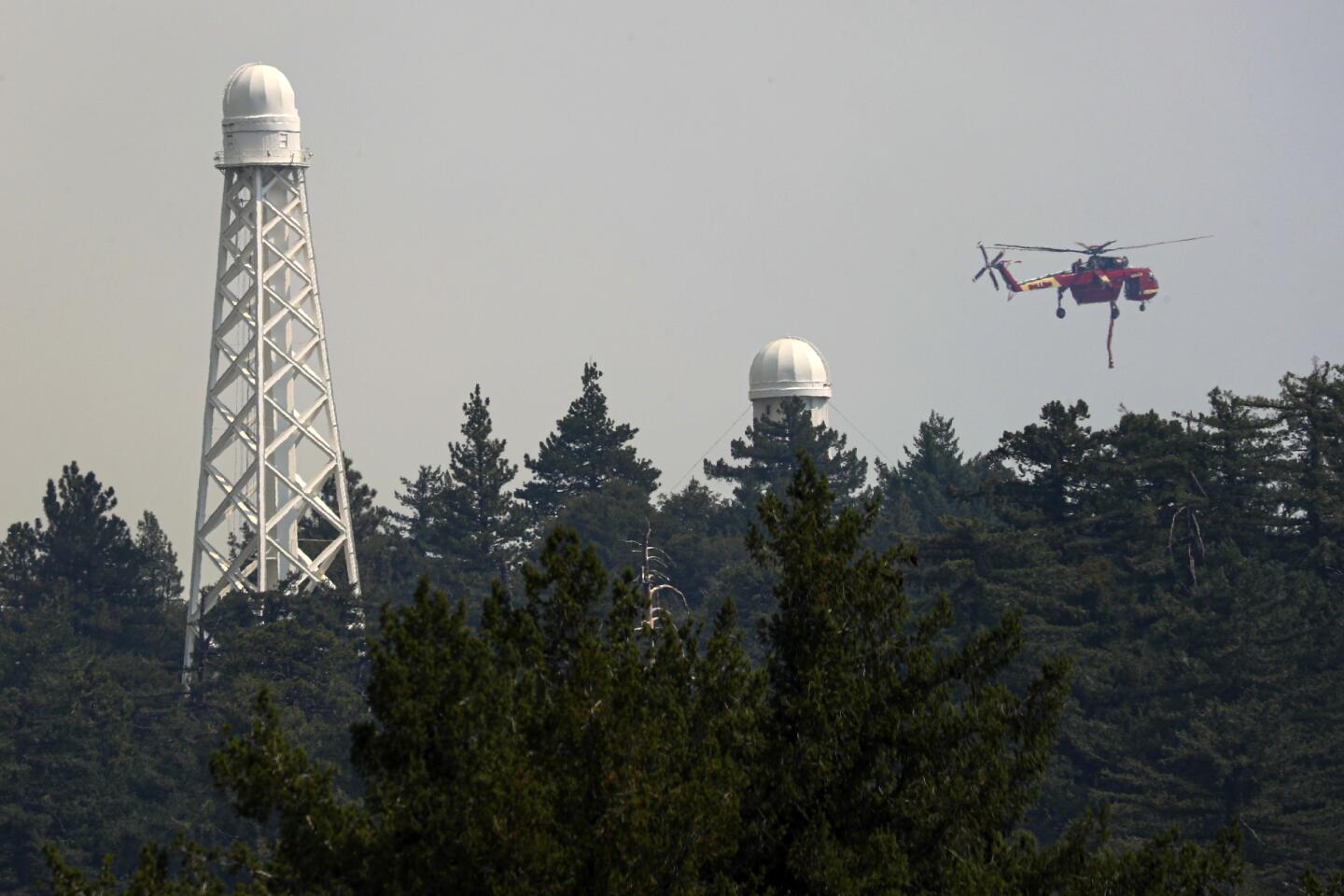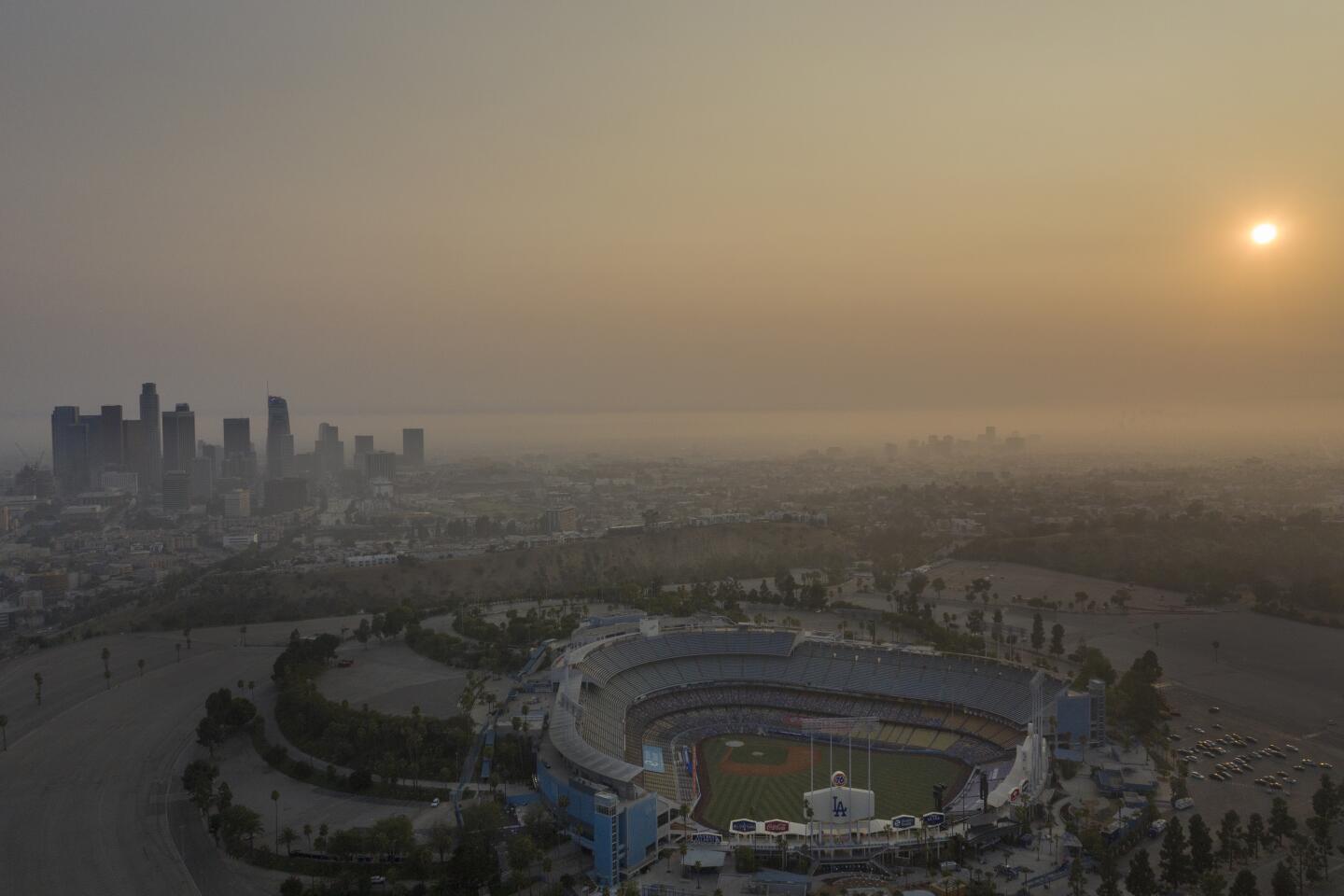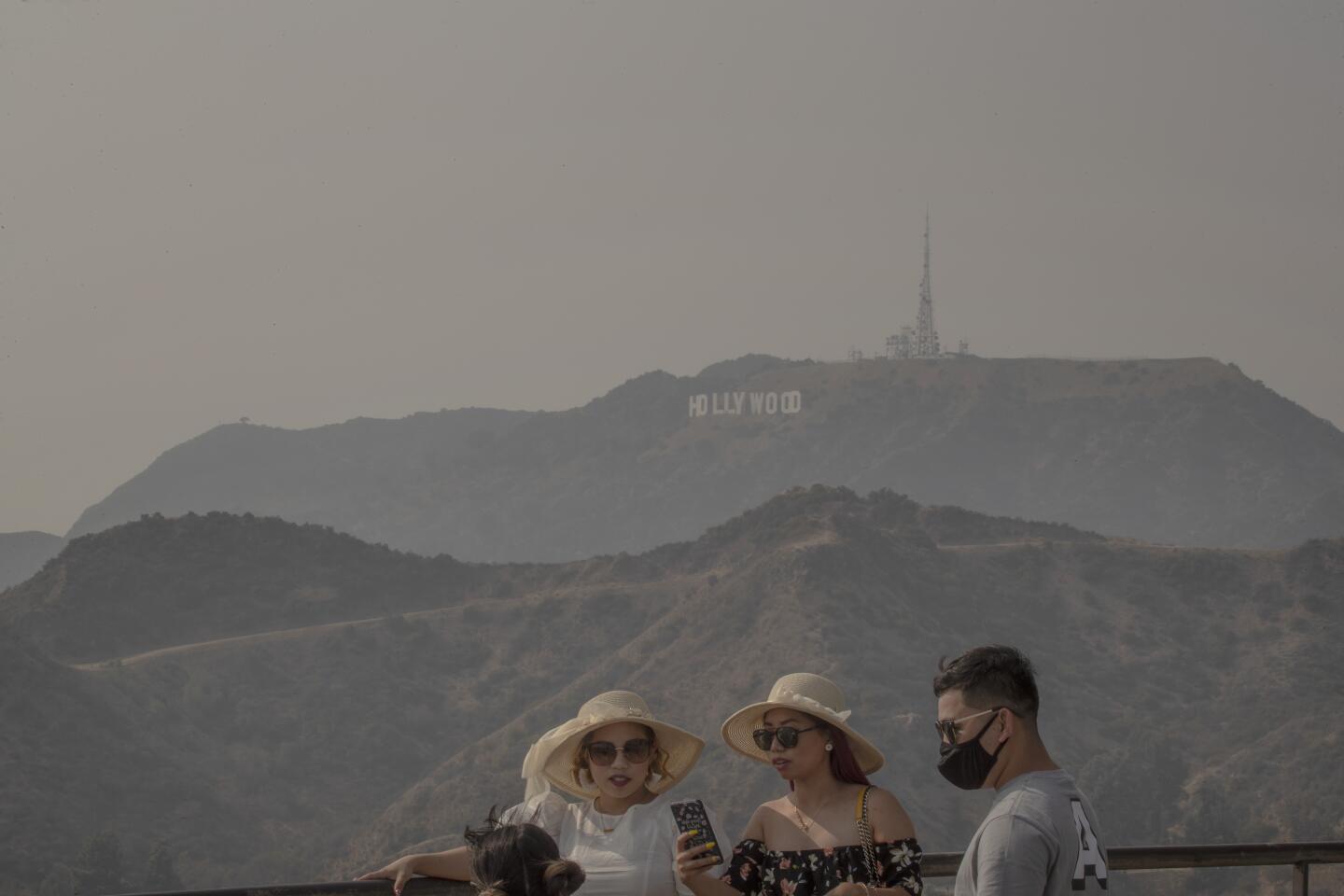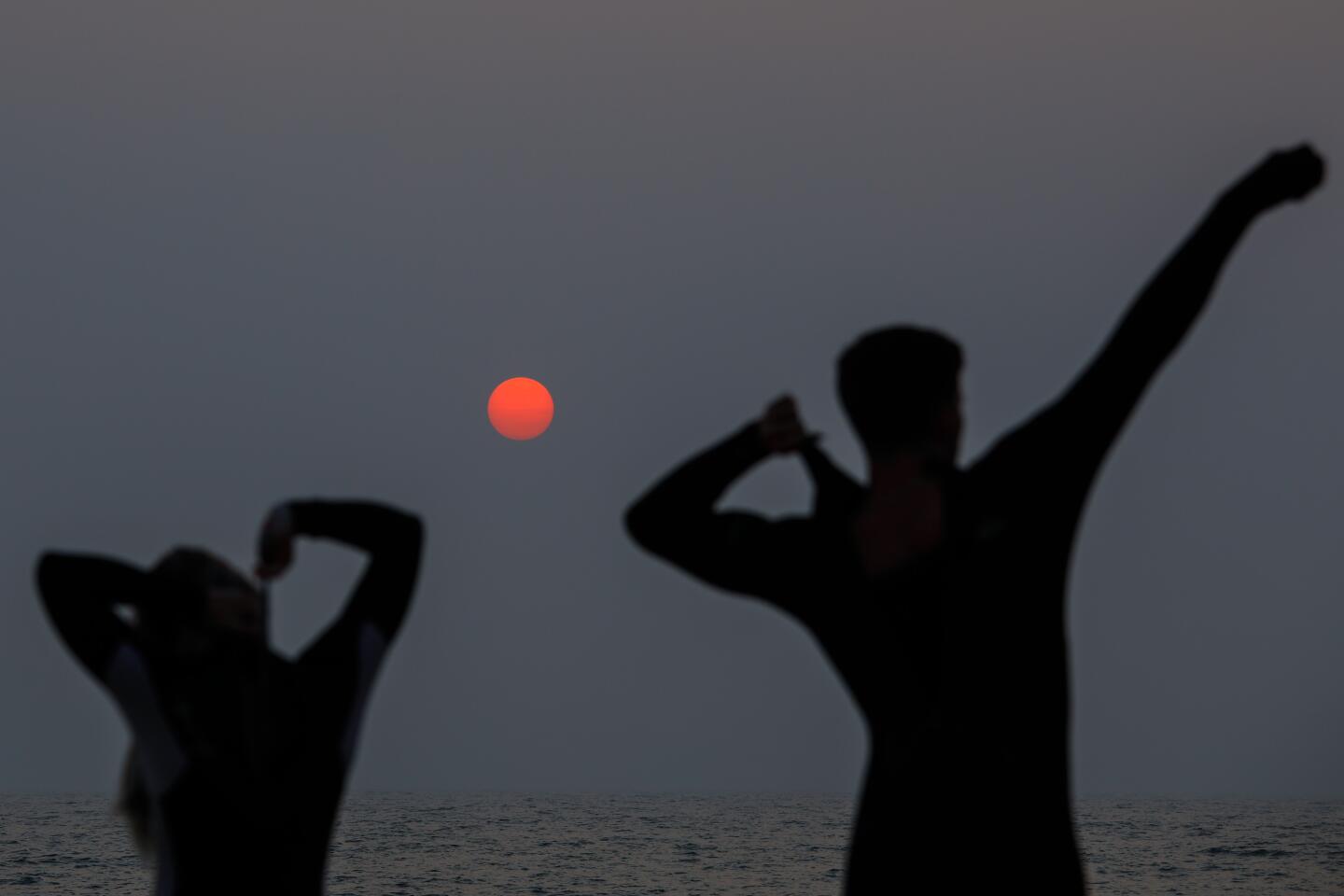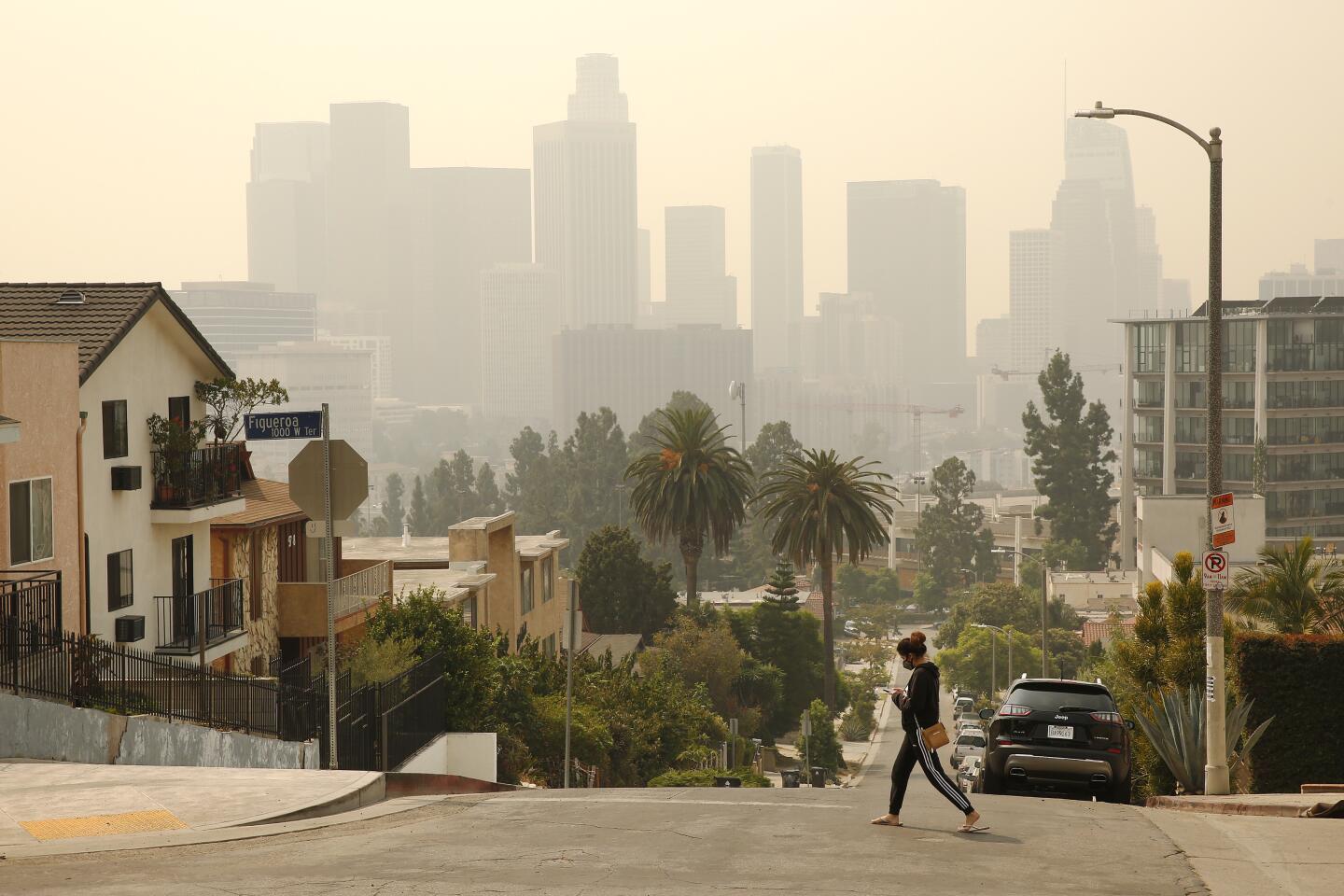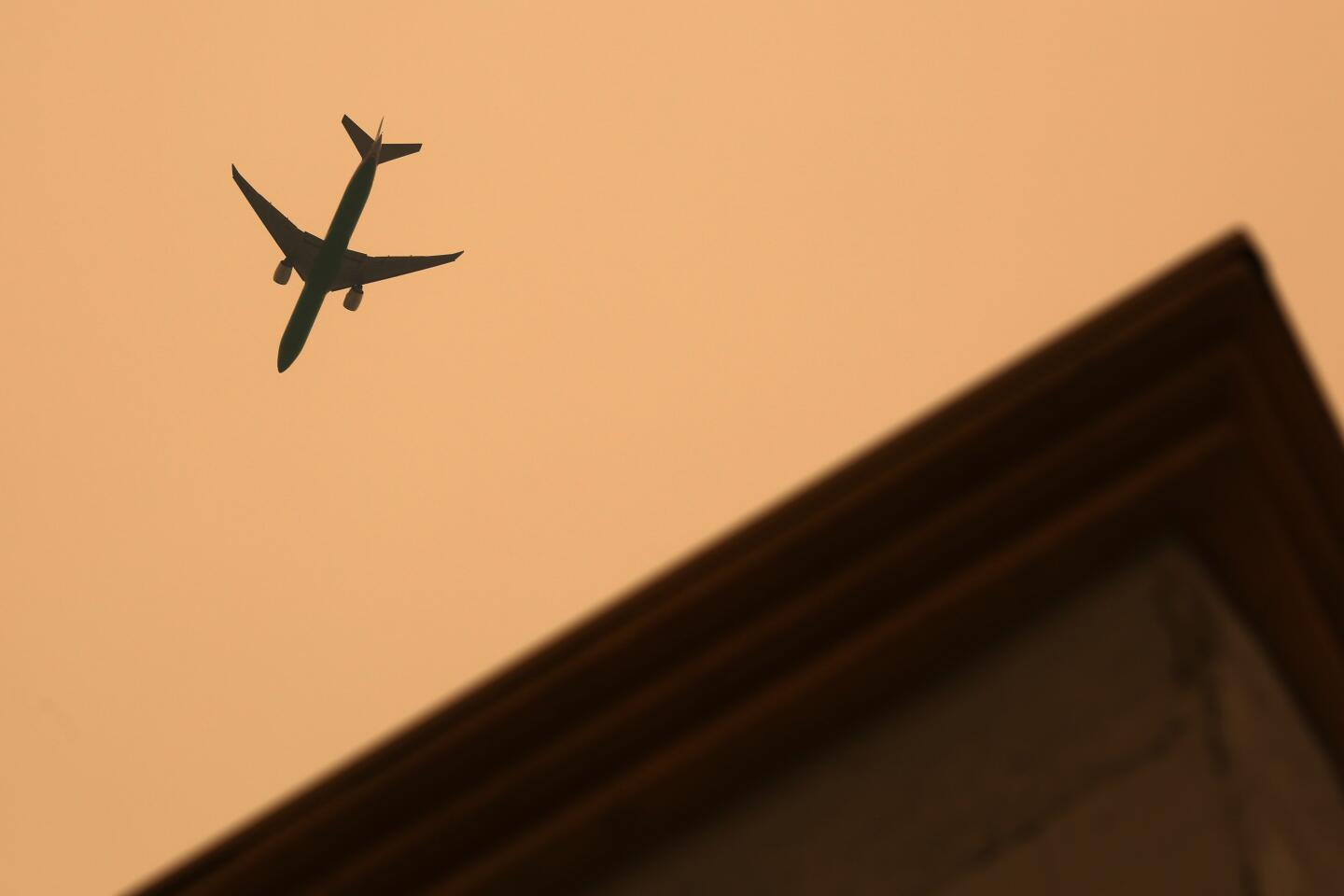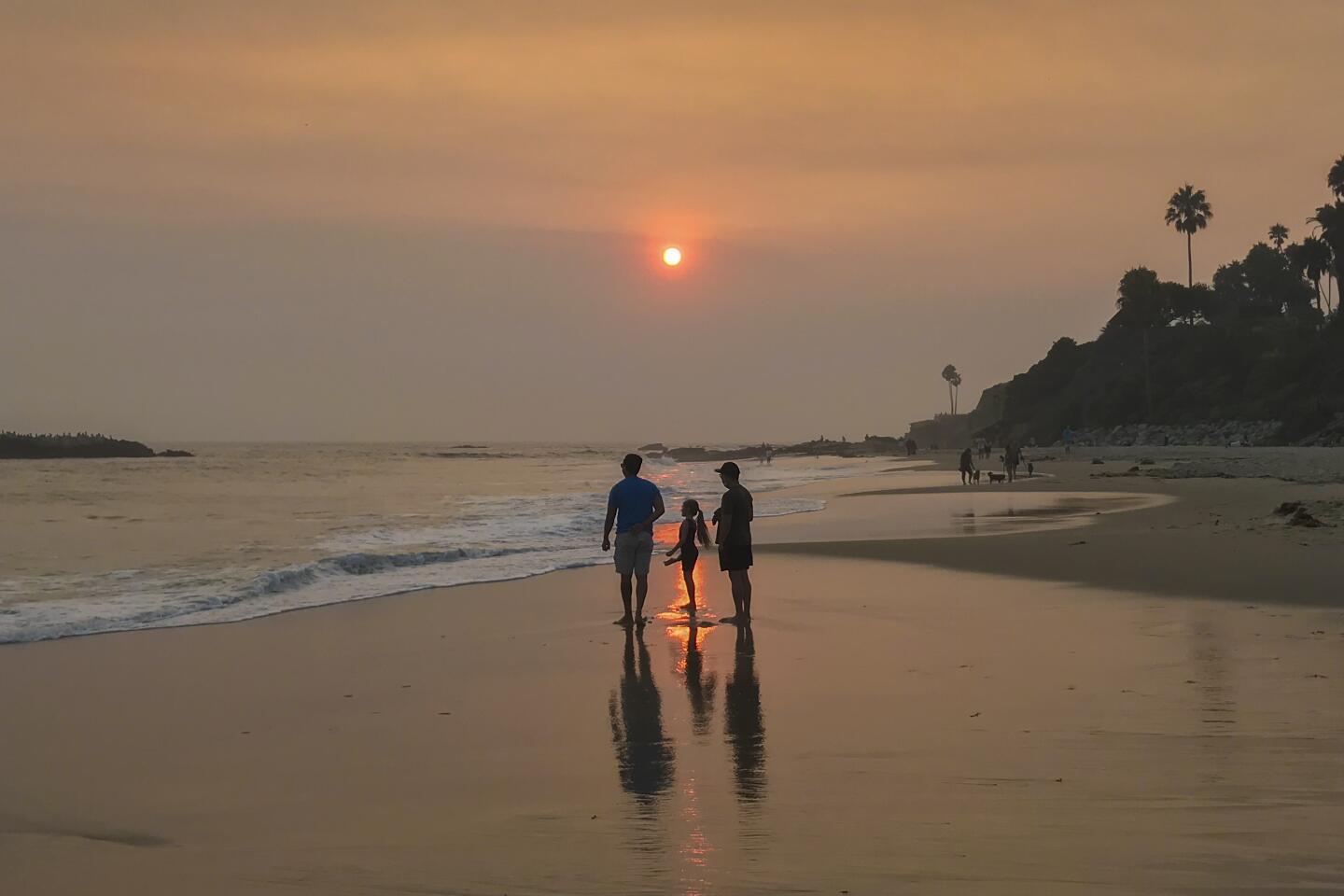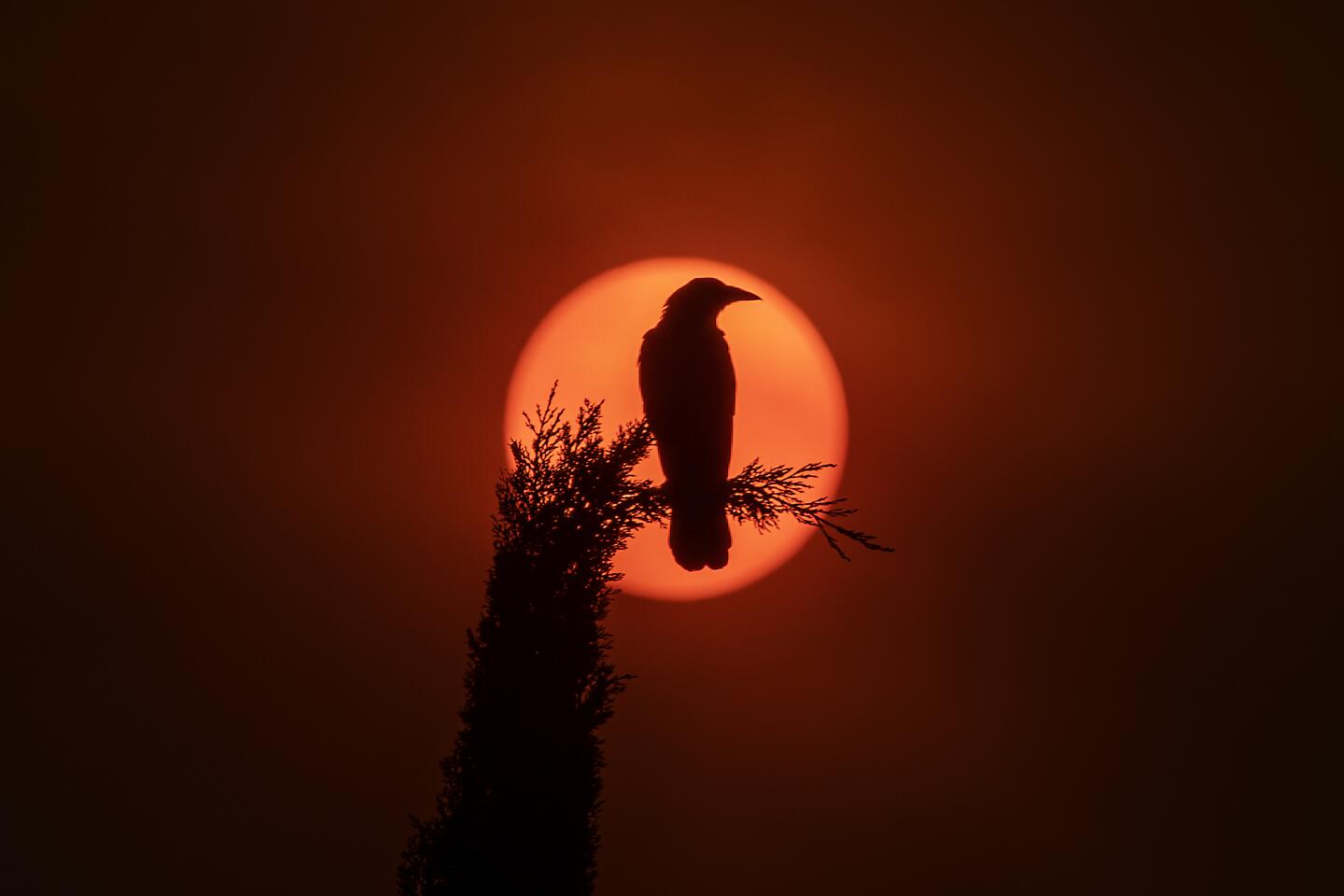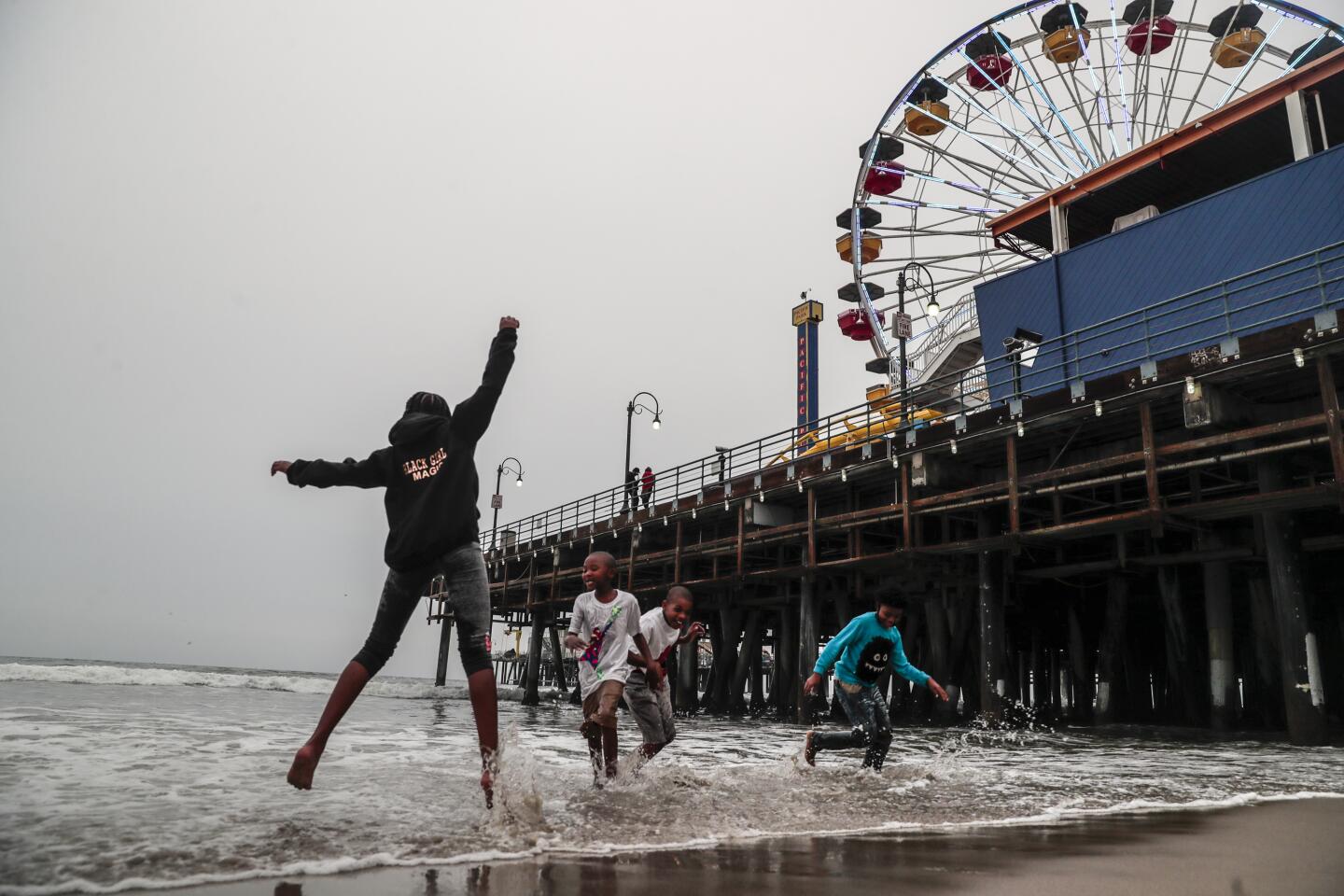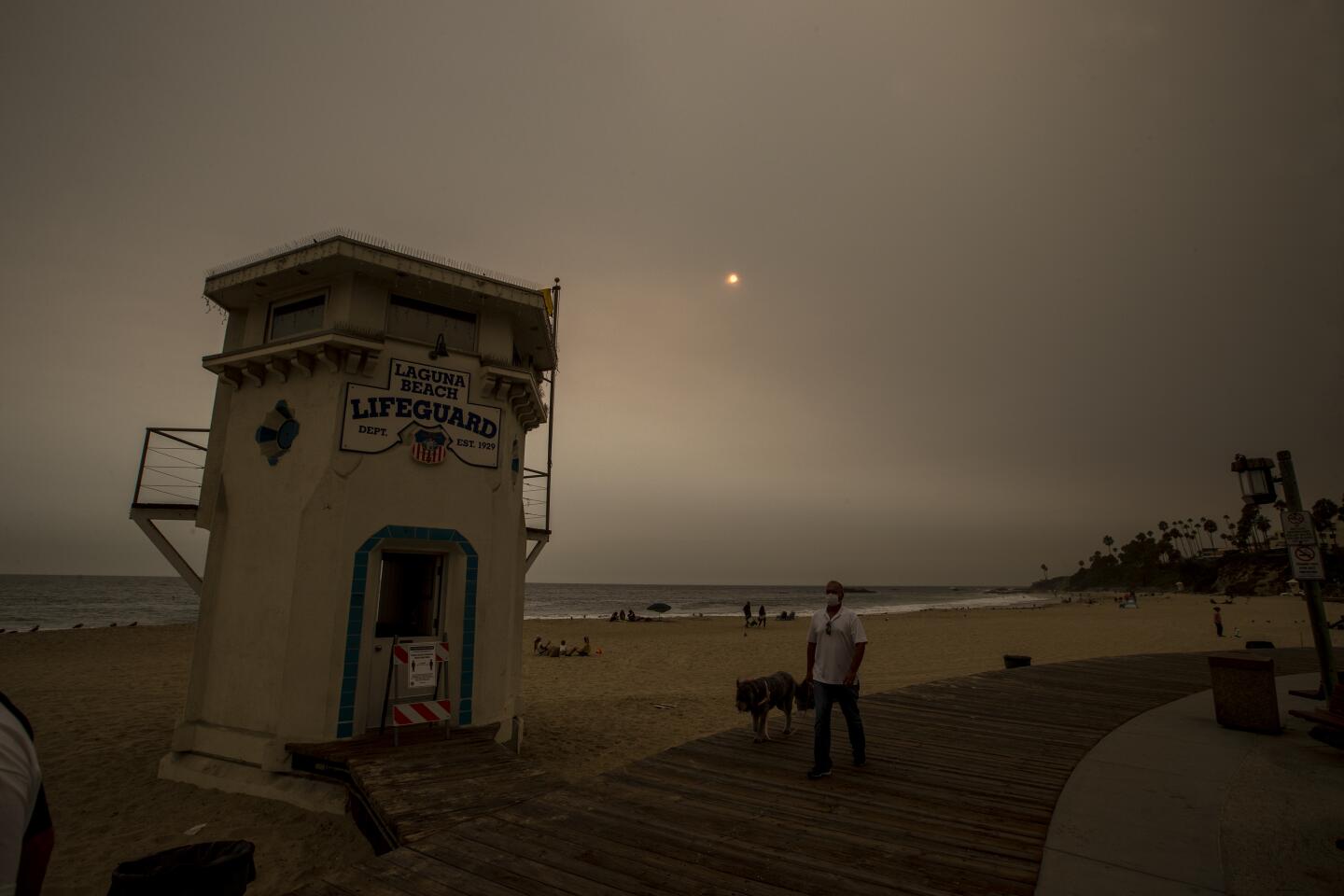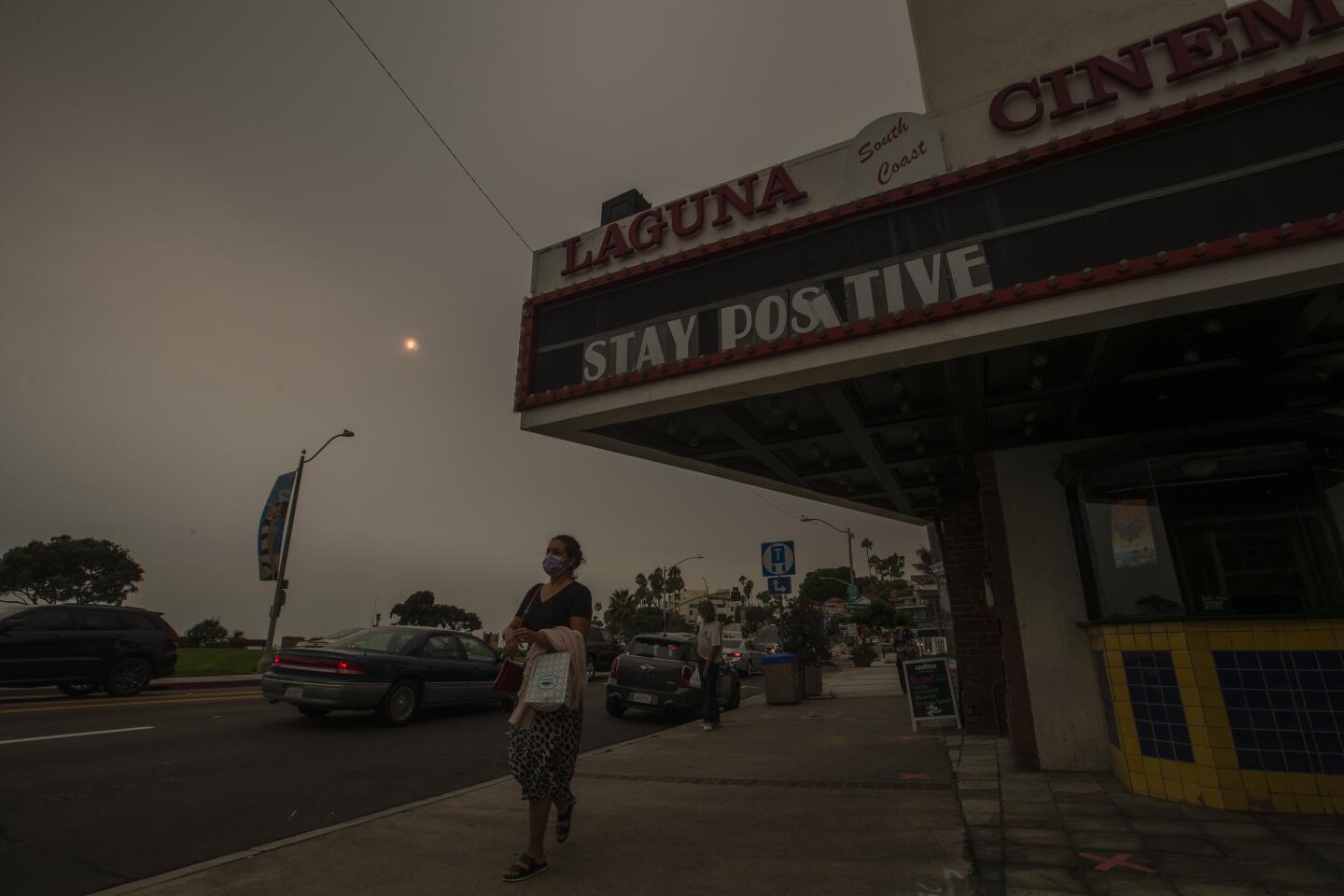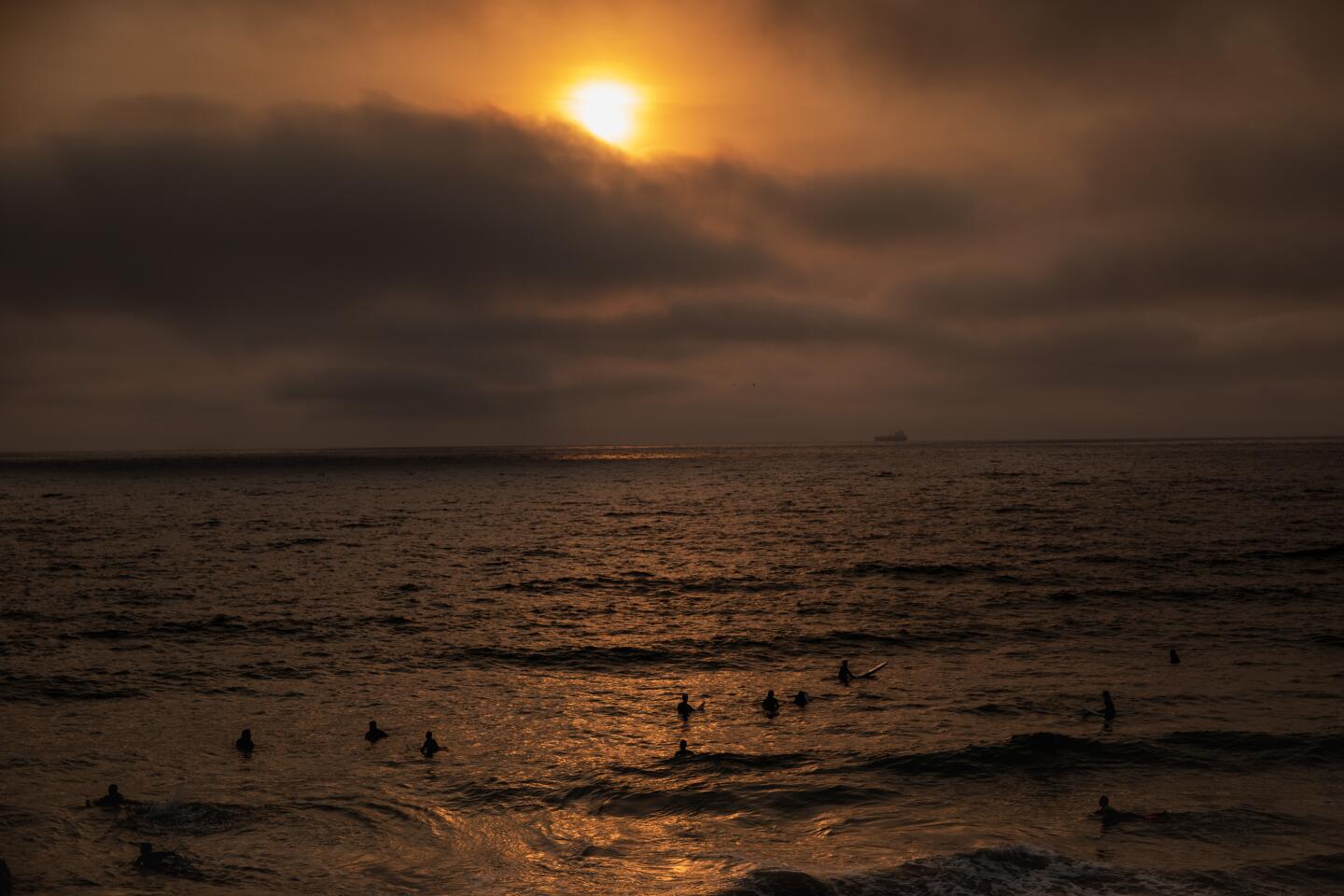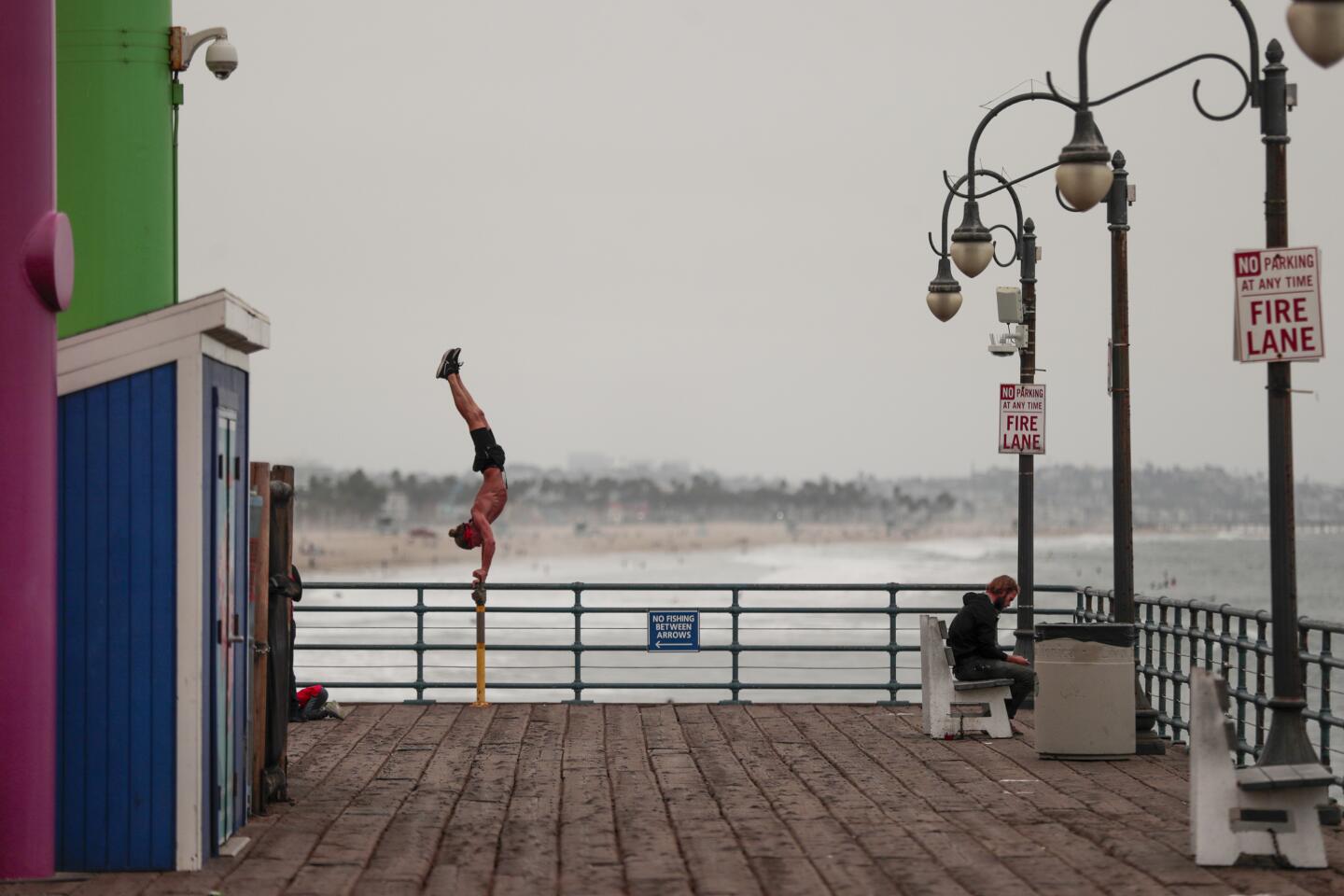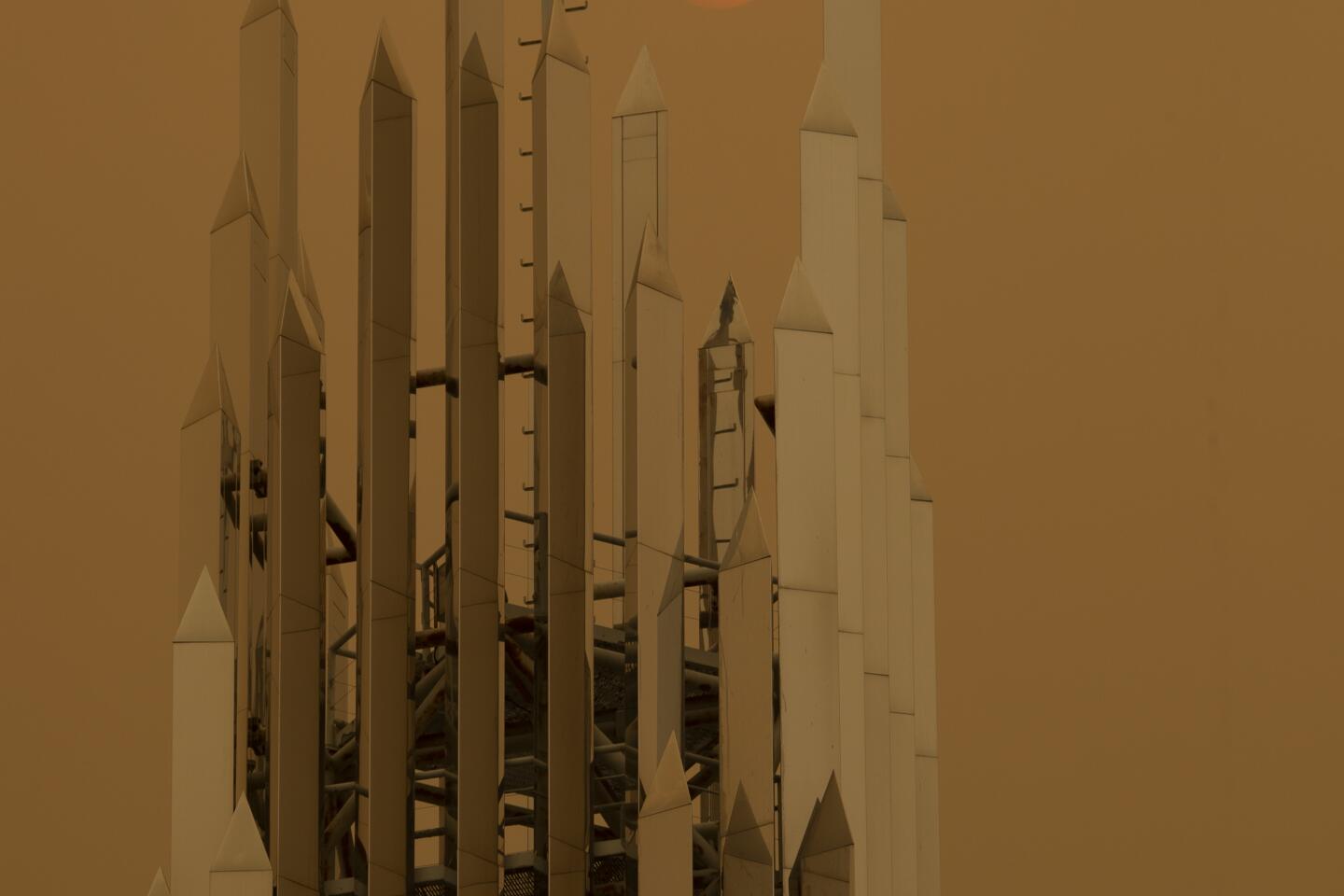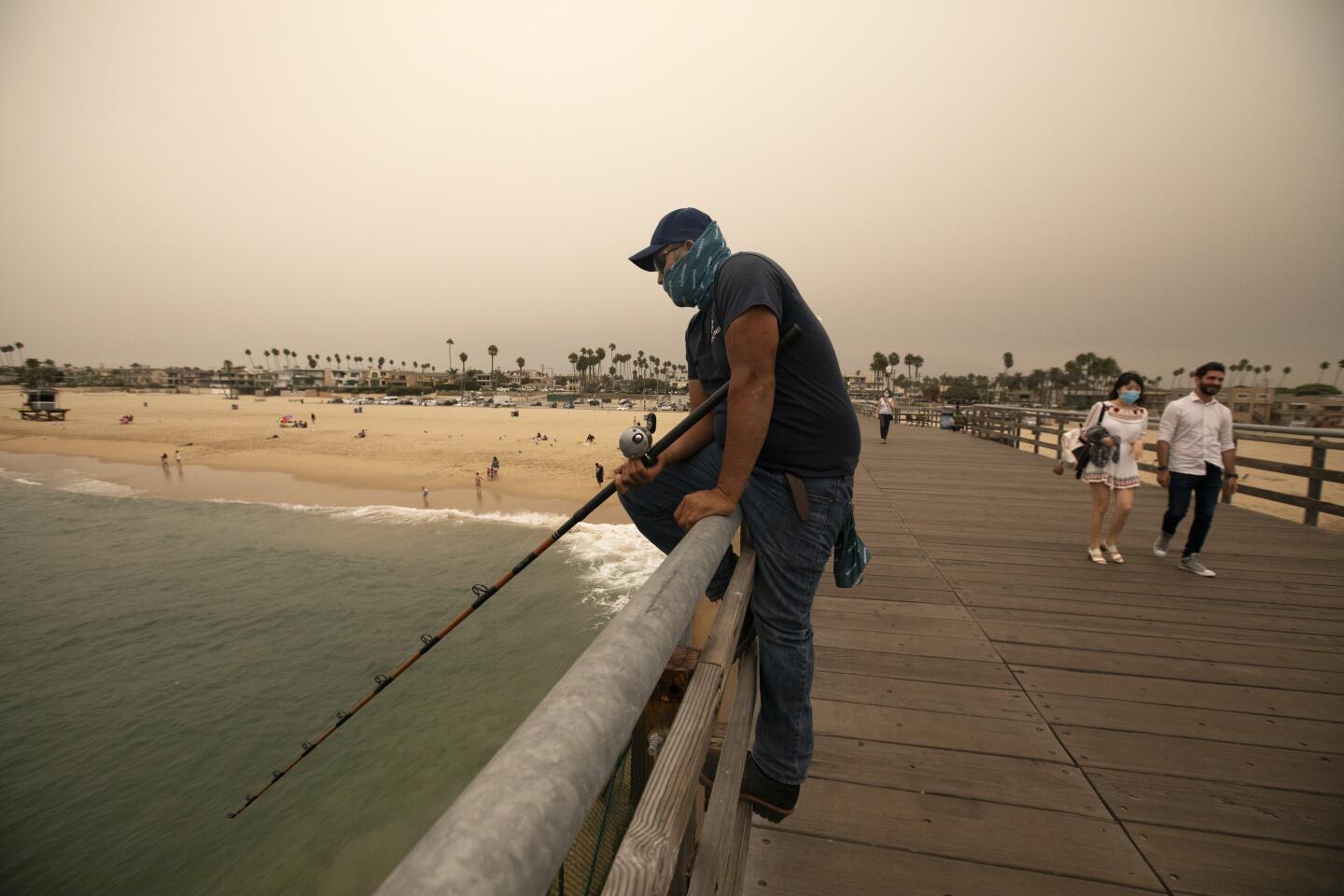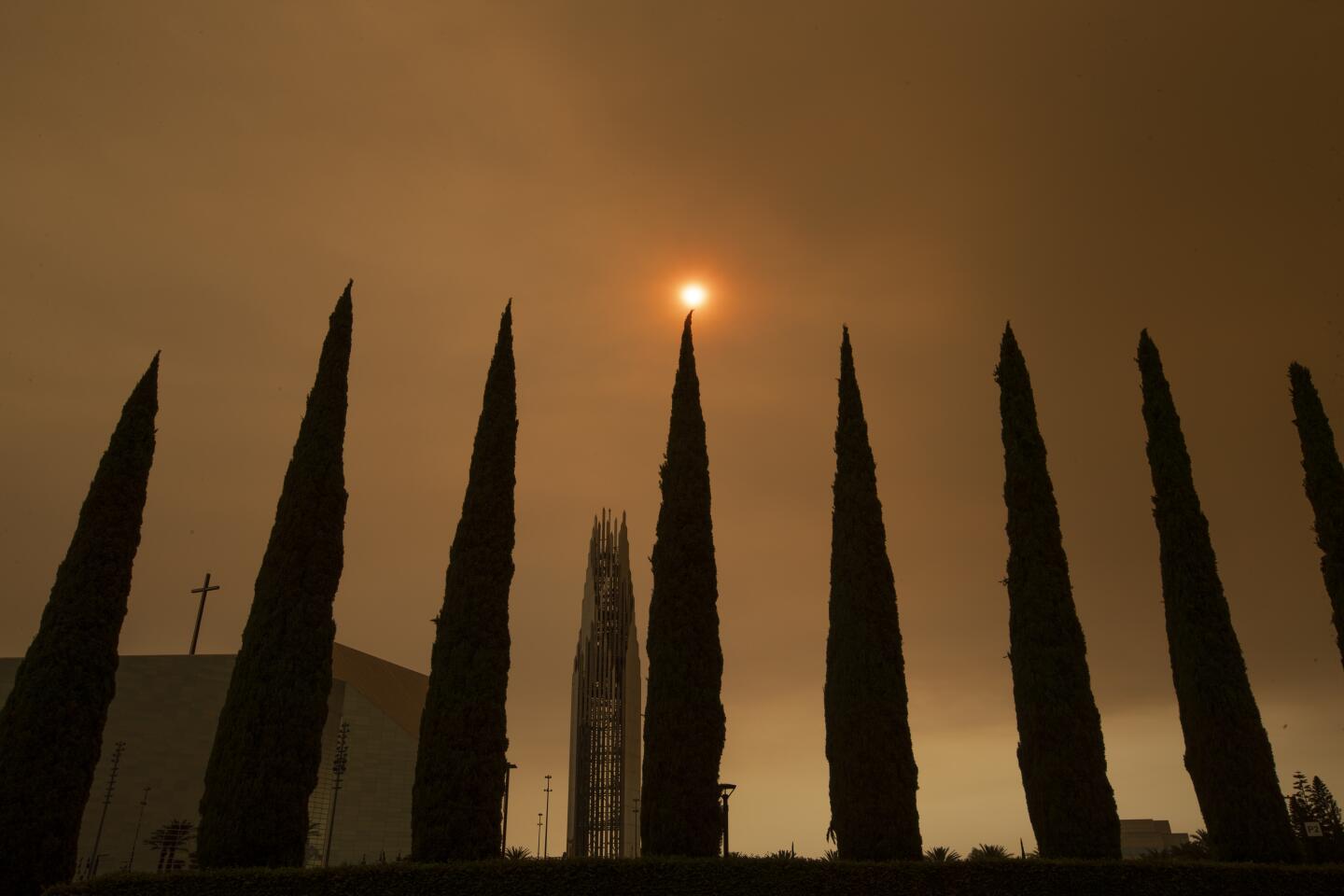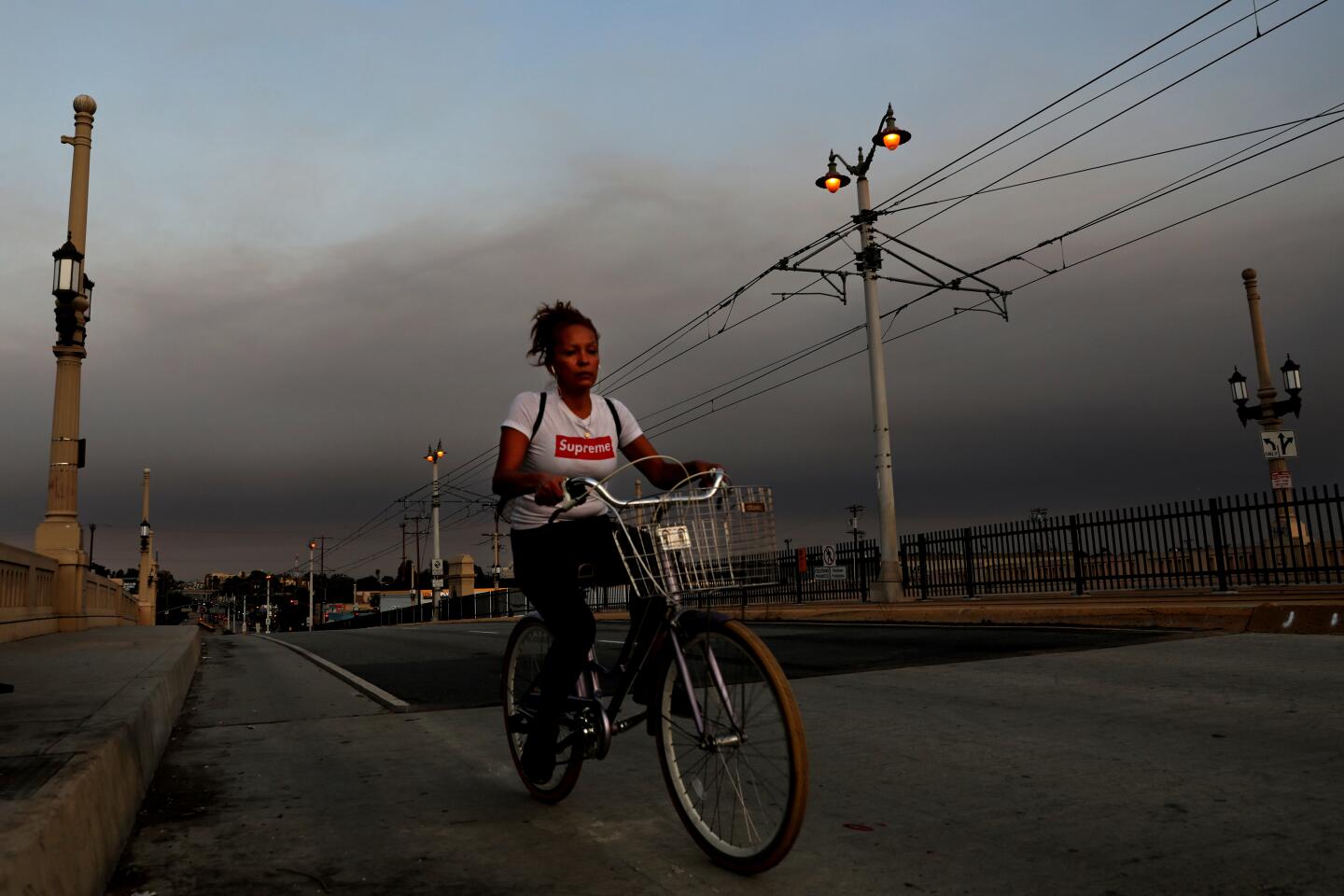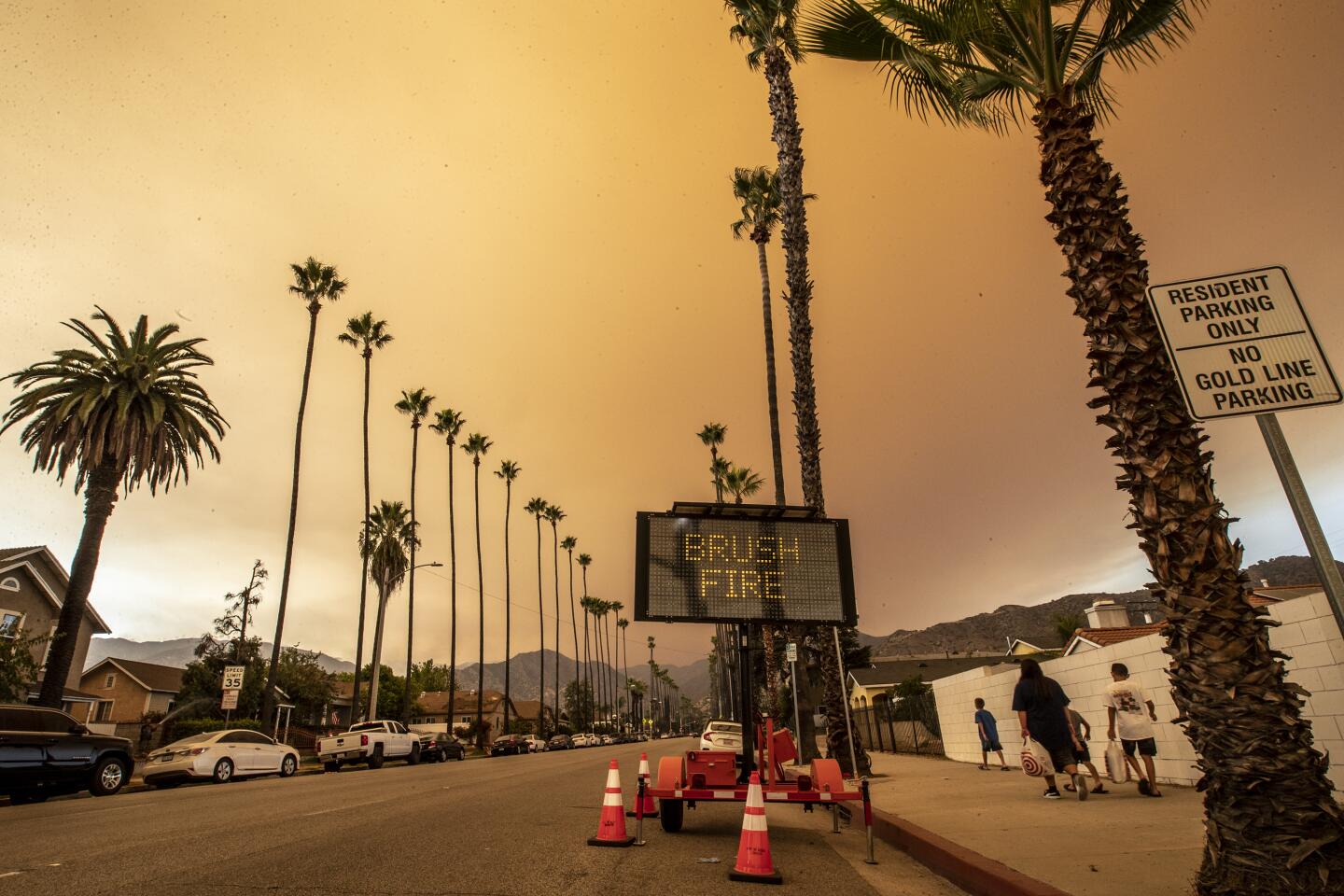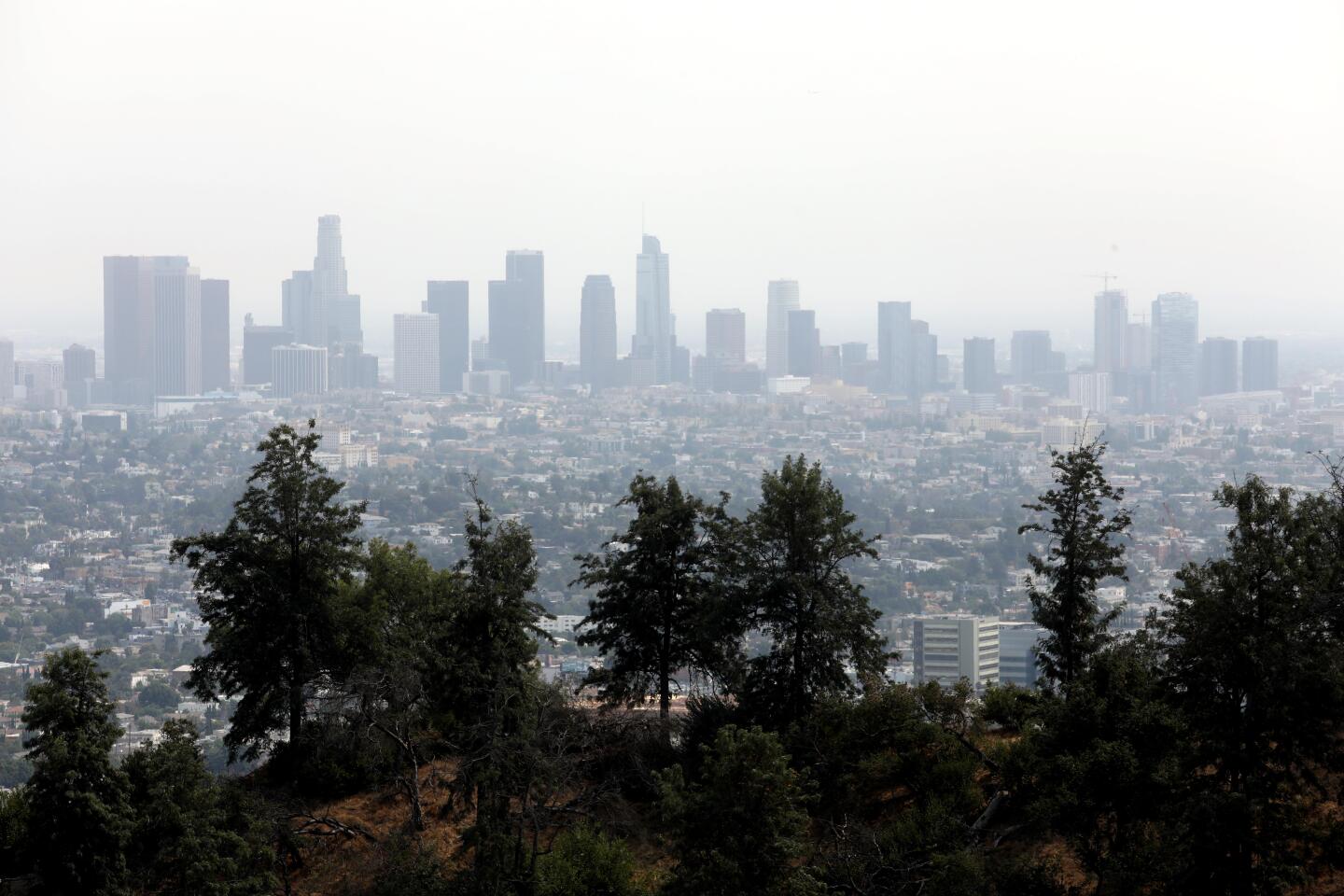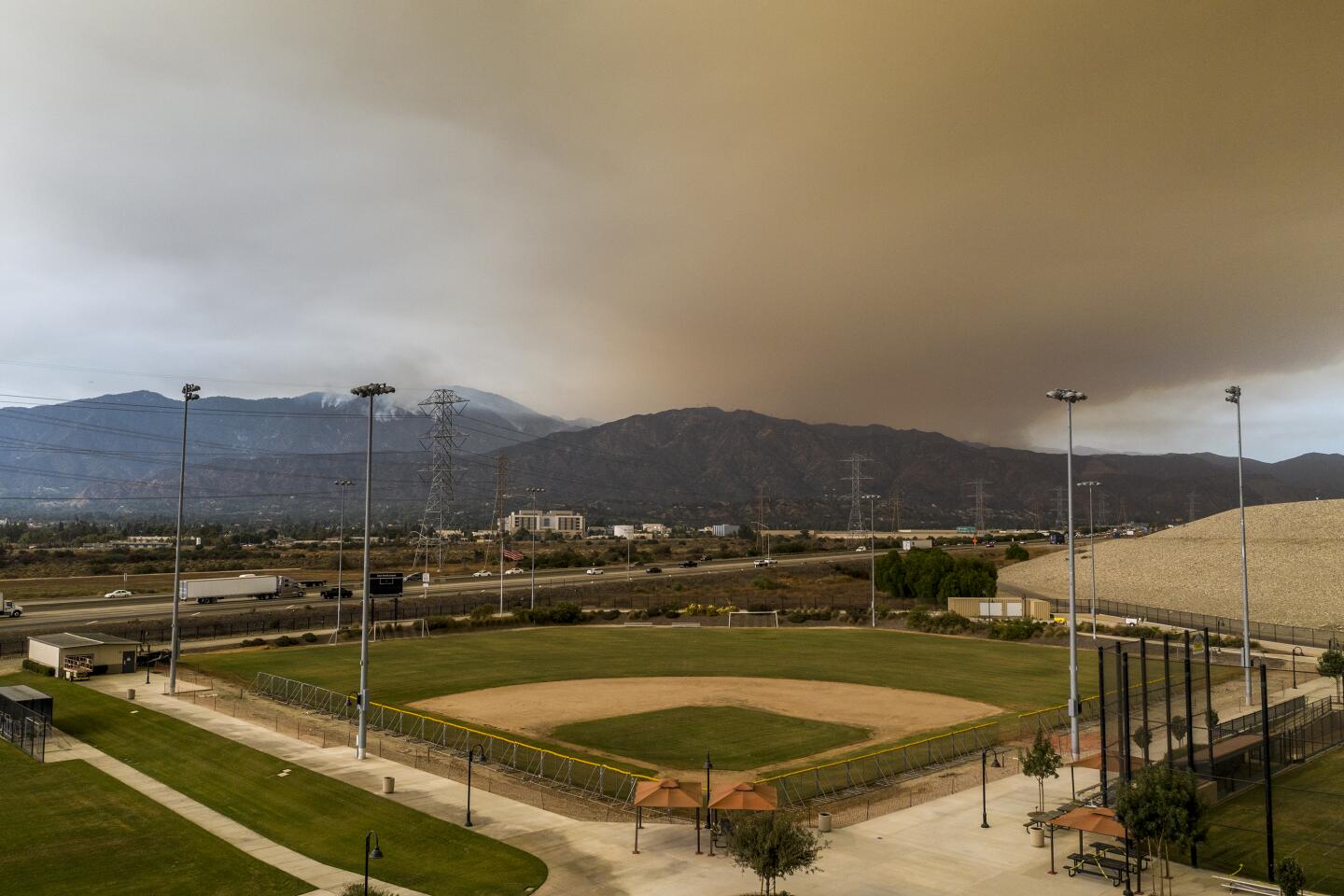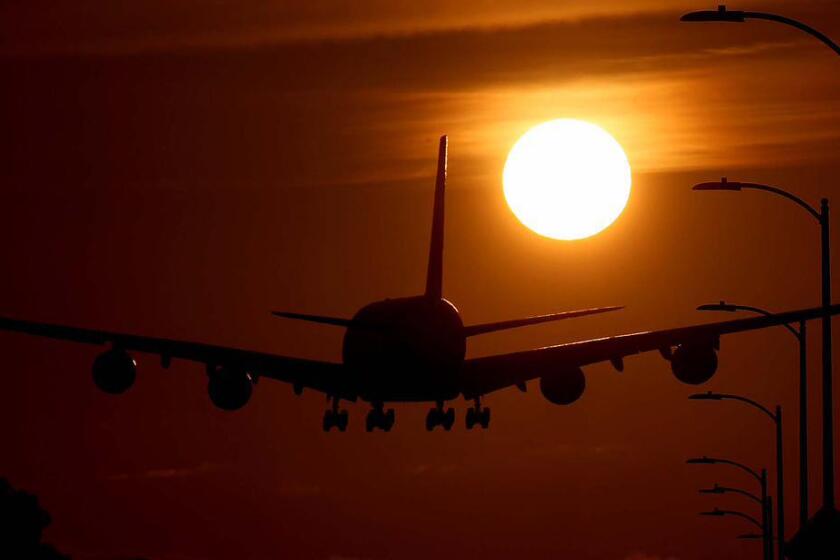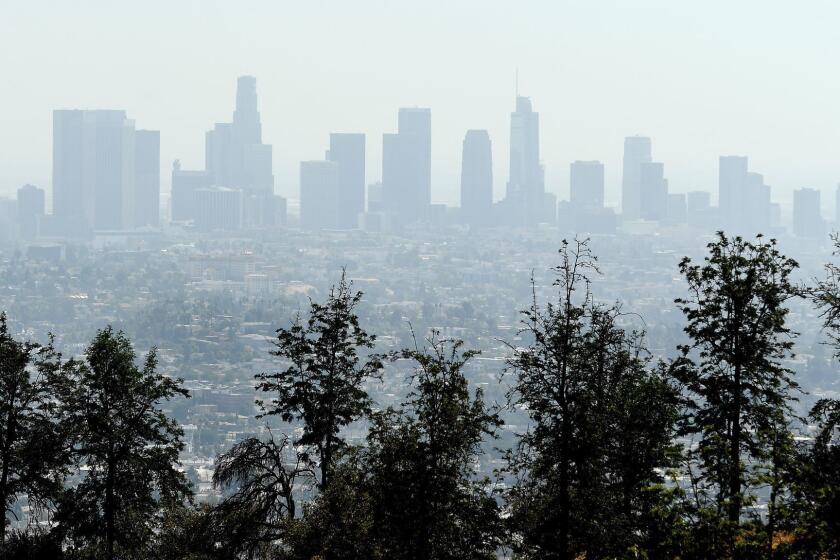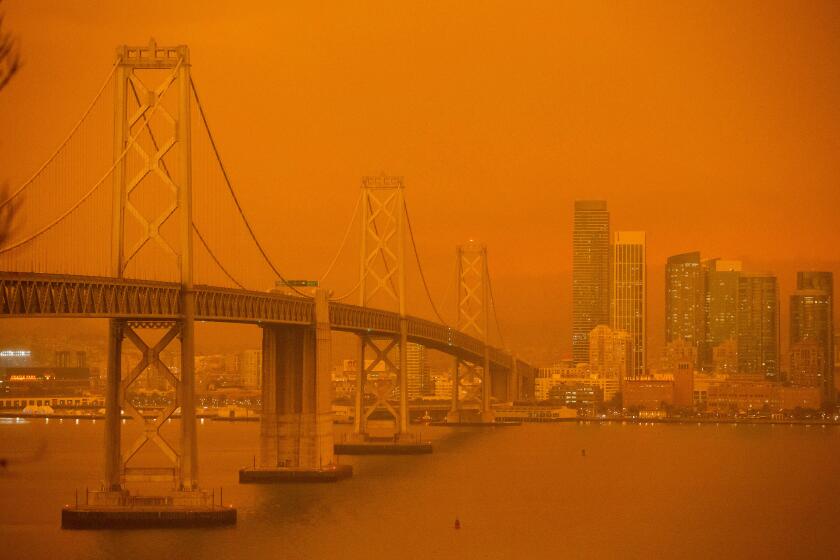Los Angeles suffers worst smog in almost 30 years
- Share via
Lung-damaging ozone pollution in Los Angeles reached its highest levels in a generation and set records in other parts of Southern California during the blistering Labor Day weekend heat wave, air quality readings show.
Ozone pollution spiked to 185 parts per billion in downtown Los Angeles at midday Sunday, according to South Coast Air Quality Management District monitoring data. It was the highest hourly reading in Southern California since 2003 and the highest in downtown L.A. in 26 years.
The eight-hour average ozone level in downtown L.A. was 118 ppb, “very unhealthy” on the Air Quality Index and far above the federal standard of 70 ppb. The last time ozone readings were that high in downtown L.A., by either measure, was in 1994, at a time when emissions were much higher and smog dramatically worse.
In Orange County, the eight-hour average ozone reading in Mission Viejo was 123 ppb, the highest on record since monitoring began at that location in 2000. Compton’s eight-hour reading was 115 ppb, its highest since monitoring began there in 2008.
As a second major heat bears down on Southern California, experts are warning the public to take seriously the health dangers of extreme temperatures.
Sunday’s readings at the downtown L.A. air monitoring station, located on North Main Street in Chinatown, were so far above normal that they triggered a quality control check designed to prevent the release of erroneous data, air quality officials said.
The downtown L.A. readings did not initially appear online and were provided by the South Coast air district in response to questions from The Times about the missing data.
The figures were not reported immediately because the quality control check requires additional, manual validation if pollution readings exceed historic highs, South Coast AQMD spokeswoman Nahal Mogharabi said. If instruments are having problems, they “can show erroneously high levels and the quality control check prevents the automated release of high data that could be incorrect.”
But it was no glitch.
“The value for noon on Sunday has been reviewed and is preliminarily valid at 185 ppb,” Mogharabi said.
The war on smog has been called one of America’s greatest environmental successes.
Air quality officials said the high pollution readings were a result of intense heat combined with stagnant weather conditions and winds that were too weak to sweep away much pollution. Temperatures in Los Angeles County exceeded 120 degrees Sunday for the first time on record, thanks to a high-pressure system that also trapped dirty air close to the ground and allowed smog levels to build up.
Unusually bad pollution is only the latest extreme to hit California in recent weeks. California recorded its hottest August on record, said UCLA climate scientist Daniel Swain, who tweeted Thursday that the distinction is “probably not a surprise to anyone who just lived through it.” Temperatures spiked during the muggy, long-lasting heat wave that hung over the region in mid-August, and they were followed soon after by a second record-setting heat spell that made for a sweltering Labor Day weekend.
In the big picture, climate change is an underlying cause of the increase in smog, according to air quality experts. Scientific studies have found that rising temperatures are making smog harder to control by speeding up the photochemical reactions that generate ozone gas. And wildfires, which are growing more intense and destructive with the warming climate, only spew more smog-forming pollutants into the air.
“The combination of a major wildfire and extreme heat can really send ozone levels through the roof,” said Yifang Zhu, a professor of environmental health sciences at UCLA Fielding School of Public Health. “Both are important, and they came together at a very unfortunate time, and that helps explain why we were seeing such extreme levels of ozone last weekend.”
“If we don’t do more than we are now to combat climate change, it’s going to happen again and again,” Zhu added.
Southern California has long suffered the nation’s worst levels of ozone. The corrosive gas, which inflames the lungs and triggers asthma attacks and other health problems, is not emitted directly but forms when pollution from cars, trucks, factories and other sources bakes in the heat and sunlight. So it’s no coincidence that the highest ozone readings usually happen when the weather is hottest.
In recent years, ozone has been worst in the Inland Empire. But this past weekend’s heat wave was marked by abnormally high smog levels even in coastal communities that typically enjoy cleaner air. Ozone reached “very unhealthy” on the Air Quality Index across much of the basin on Sunday, including the Westside, southeast L.A. County, northern Orange County and the San Gabriel Valley.
The spike in ozone comes just months after many rejoiced over the perceived air-cleaning effects of the coronavirus lockdown. Dramatic reductions in traffic emissions certainly contributed to lower smog levels — including a 21-day stretch of good air days that was the L.A. area’s longest in decades — but air quality experts believe much of the apparent improvement was, in fact, due to stormy spring weather.
By April 1, the region had logged its first bad air day since stay-at-home-orders took effect, and it racked up a string of additional violations as temperatures climbed into the 90s later that month. By the first week of May, a heat wave had pushed ozone levels into the “very unhealthy” range again.
Cesunica Ivey, an assistant professor of chemical and environmental engineering at UC Riverside, said her research into air quality impacts during the COVID-19 shutdown found that in March and April, levels of ozone actually increased slightly in areas of Southern California with typically cleaner air, such as Pasadena, while dropping slightly in smoggier areas such as the Inland Empire.
“We’re still investigating the extent to which this overall reduction in commuter activity, along with these extreme heat events, are combining to give us these 1994 levels of ozone,” Ivey said.
Mogharabi said the air district also is investigating whether a COVID-related shift in the balance between the two main smog-forming pollutants — combustion gases called nitrogen oxides and chemical vapors and solvents called volatile organic compounds — has contributed to the abnormally high ozone readings.
With so many fires burning, millions of people in the Bay Area, Central Valley and parts of Southern California are breathing dangerous levels of particle pollution.
The awful air quality marks the latest setback in the fight against Southern California smog, which has faltered in recent years despite a long-term decrease in emissions.
Officials with the South Coast air district, which regulates air pollution across a region of 17 million people spanning Los Angeles, Orange, Riverside and San Bernardino counties, have blamed hotter weather and stronger, more persistent pollution-trapping inversion layers. They are also studying to what extent climate change is driving recent increases in ozone.
“The changing climate, weather extremes and wildfire seasons do play a role, but it is very hard to definitively attribute a few years of extreme weather to longer-term climate change trends,” Mogharabi said. “However, if these uncontrollable events such as this past weekend, or the ozone event we experienced in the spring, become more frequent or more extreme, it would then negatively impact ozone levels and our ability to meet federal attainment standards.”
The unhealthy smog readings occurred during a period in which Gov. Gavin Newsom temporarily suspended air-quality rules on power plants, cargo ships in port and other major pollution sources to ease strain on the power grid during the two recent heat waves. Southern California air quality regulators said they don’t know whether higher-than-usual emissions played a role but are gathering information.
More to Read
Sign up for Essential California
The most important California stories and recommendations in your inbox every morning.
You may occasionally receive promotional content from the Los Angeles Times.
